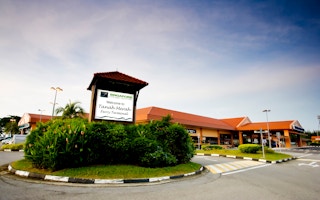Tanah Merah Ferry Terminal is about to become the first solar-powered ferry terminal in Singapore and the Asia-Pacific region.
To continue reading, subscribe to Eco‑Business.
There's something for everyone. We offer a range of subscription plans.
- Access our stories and receive our Insights Weekly newsletter with the free EB Member plan.
- Unlock unlimited access to our content and archive with EB Circle.
- Publish your content with EB Premium.
In an announcement last week, operator Singapore Cruise Centre (SCC) said it is partnering local solar firm Sunseap Group to source all of Tanah Merah Ferry Terminal’s energy requirements.
The two firms have agreed on a solar power purchasing deal that will see Sunseap absorb the equipment and installation costs for a 650 kiloWatt peak solar panel system to be fitted on the roof of the terminal.
The system, when completed, will supply the terminal with one-third of its daily energy needs, and the remaining two-thirds will be met by electricity from the grid.
Christina Siaw, CEO of SCC, told Eco-Business that SCC had launched an energy supply tender for Tanah Merah Ferry Terminal a year ago to reduce the company’s carbon footprint and energy costs.
The system is expected to be up and running by June this year and will offset at least 327 tonnes of carbon dioxide annually.
Tanah Merah Ferry Terminal, which consumes 3.4 million kilowatts of energy per year, is a popular departure point for Singapore holidaymakers travelling to the nearby Indonesian islands of Batam and Bintan.
“The deal with Sunseap will allow us to tap solar power but still be assured of stability of energy supply to keep our terminal running smoothly. At the same time, we are reducing our carbon footprint and achieving savings on our electricity bills,” Siaw said in a statement.
SCC also manages the ferry terminal at Pasir Panjang, and the ferry and cruise terminals at Harbourfront. The latter is a homeport for major cruiseline Star Cruises.
Asked if SCC would set up another solar power system at its Harbourfront cruise terminal, Siaw told Eco-Business that the company is “open” to exploring how the carbon footprint of its terminals can be reduced and will share its plans once they are finalised.
Frank Phuan, co-founder and director of Sunseap, commented in a statement that the firm’s hybrid energy offers, combining clean solar energy and traditional energy from the grid, helps clients adopt clean energy more easily.
SCC’s decision to move Tanah Merah Ferry Terminal towards a less carbon-intensive source of energy is timely as Singapore works on cutting its carbon emissions. The city-state recently announced that it would implement a carbon tax on large-scale carbon emitters, such as power stations, starting in 2019. The move is expected to impact electricity prices and in turn, operational costs for businesses.










